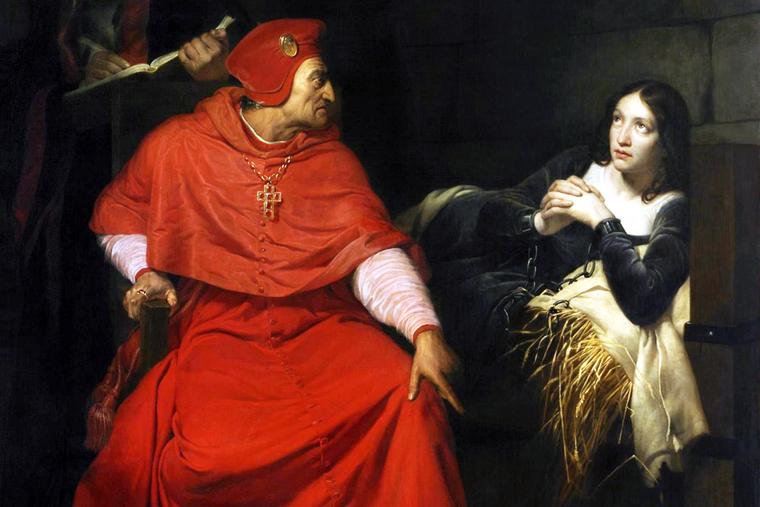At Her Trial, St. Joan of Arc Faced Her Accusers Alone
“But Joan had no one to prepare her case for her, and she was shut up in those stone walls and had no friend to appeal to for help…”

The odds wouldn’t favor an illiterate peasant girl left to manage her own defense in court against 50 learned and unsympathetic ecclesiastics, but God, the angels and saints were on her side.
St. Joan of Arc exhausted her accusers by brilliantly sidestepping their traps as she was being tried for heresy and other baseless crimes in Rouen, France. Despite her inspired testimony, God called St. Joan to martyrdom and at age 19 she was burned at the stake after several months in court on May 30, 1431.
Becoming a celebrated military leader was not St. Joan’s plan while growing up in the French village of Domrémy, but it was God’s plan. As a young girl she began to have visions of the Archangel Michael, St. Catherine of Alexandria and St. Margaret of Antioch. At 16 her “Voices” instructed her to lead the French army to victory over the English during the Hundred Years War and to bring the future French king to Reims to be crowned.
The Voices guided Joan to major successes on the battlefield, though they later raised suspicion among her enemies. She was acclaimed by the French people and called the “Maid of Orleans” for her role in lifting the nearly seven-month siege of that city.
During a battle in May 1430, Joan was captured by English-sympathizing troops from the province of Burgundy. After several months she was sold to the English.
As a soldier innocent of crimes of military law, Joan was eligible for ransom, but the French king offered none and left her languishing in prison.
Joan was charged as a heretic, a crime tried by a Church court. A leader of the Inquisition refused to take on the case because she had already been tried by a higher court at the outset of her military career. Bishop Pierre Cauchon of Beauvais, in whose diocese Joan was captured, was placed in charge of the trial.
When the trial began, Joan sat alone facing her accusers, though as a minor Church law entitled her to counsel. Mark Twain wrote about her lack of assistance in a biography entitled, Personal Recollections of Joan of Arc:
“But Joan had no one to prepare her case for her, and she was shut up in those stone walls and had no friend to appeal to for help. And as for witnesses, she could not call a single one in her defense. …. No, the prisoner must be the sole witness — witness for the prosecution, witness for the defense; and with a verdict of death resolved upon before the doors were opened for the court’s first sitting.”
Not only did Joan have to provide her own defense, but Bishop Cauchon painstakingly removed all exculpatory evidence from the proceedings of her previous trial and a report on her background.
Once, as the bishop was interrogating her in her cell, a judge who was with him suggested that Joan be allowed to appeal to another more sympathetic council. The bishop immediately ordered the comment struck from the record and Mark Twain wrote:
“Ah,” said poor Joan, reproachfully, “you set down everything that is against me, but you will not set down what is for me.”
Despite her disadvantage during the long days of questioning, Joan deflected many attempts to incriminate her. When an accuser asked her to tell if she was in a state of grace, she responded, “If I am not in God's grace, I pray that I might be. If I am, that God would keep me there.”
Later threatened with torture on the rack, she responded, “I will tell you nothing more than I have told you — no, not even if you tear the limbs from my body. And even if in my pain I did say something otherwise, I would always say afterward that it was the torture that spoke and not I.”
Bishop Cauchon created misinformation to control the narrative surrounding the trial. As crowds outside the fortress where it was being held waited for news, he ordered clerks to shout false reports about the proceedings from a window. Ultimately the clerks’ consciences prevailed, and they stopped giving the reports.
Joan’s accusers ended the trial by giving her a death sentence her, but they knew they also had to convict her in the court of public opinion, or she would live forever as a martyr in the hearts of the French people. They made it appear that she was condemning herself publicly by tricking her into signing a confession to 12 false crimes.
The French saw through the ruse. Several decades after her death, St. Joan’s honor was restored.
She was canonized in 1920 and is a patron saint of France.
- Keywords:
- st. joan of arc

















